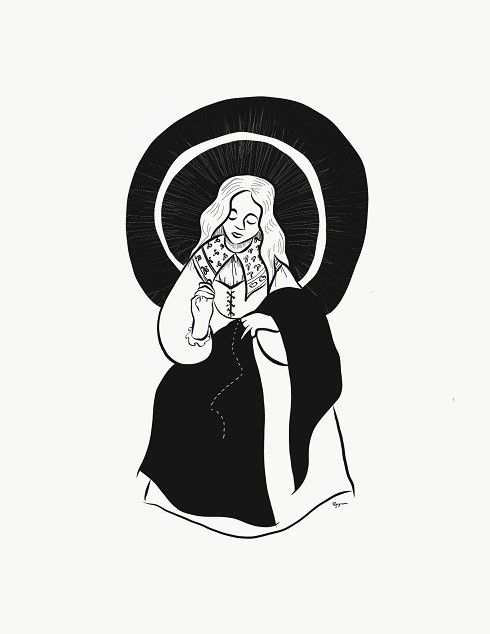Experiencing live storytelling is a rare treat these days. Those who have embraced the old art tend to flex an extreme passion for it and present breathtaking artistry. Live storytelling of folk tales occupies a unique territory between literature and theater. It's performance of stories adapted from old oral traditions that over time have become collected into folktale anthologies.
The creators behind Hnossa Project, who formed the group in New York City, have brought immersive storytelling to Rochester a handful of times, most notably presenting adaptations of old Scandinavian folktales as part of The Rochester Fringe. Now based in Rochester, Hnossa's Didrik Söderström will this week perform a new piece, "The Magician's Cape," for one night only at Writers & Books.
"Hnossa is about bringing myth and folklore back into the modern psyche," says Hnossa director and co-writer Matt Frost. "It's about taking the time to look backward and take a break from the daily rush, and sit around the fire, and tell a story. That was, for such a long time, an immensely important part of every culture."

- PHOTO BY AUTUMN KOVACH
- Hnossa Project's storyteller Didrik Söderström.
"Erik & the Wolf" was the first Hnossa performance I caught, performed at Writers & Books during the 2015 Rochester Fringe, and I was hooked. Söderström adapted the 9th- or 10th-century Swedish folktale into a multi-layered retelling. Using little more than a mic, an amp, and a loop station, he spun a strange love story into a magical, immersive yarn through spoken words, song, and vocal layering.
Söderström transported the audience to a dense forest in Northern Sweden, to a time when Christianity and old pagan traditions battled for survival. He looped and layered beautiful vocal notes, over which he sang in Swedish and English about a humble woodcutter and a shapeshifter. The environments and moods of the story were set by whistling that became birdsong, breath that became soft gusts of wind, and other man-made sounds that represented fire or encounters with beasts.
I was so impressed with the performance that I jumped at the chance to review Hnossa again when Söderström returned for the 2016 Rochester Fringe to perform one of my favorite folktales, the Norwegian tale "East of the Sun, West of the Moon." Again he bewitched the audience using only a mic, an amp, and a looper pedal, simulating the nuances of nature and punctuating bits of storytelling with soaring songs, often sung in-the-round. Half of the magic of experiencing Hnossa projects is witnessing Söderström build the stories from scratch, recreating live what he has so lovingly planned out. He's truly living in the tale while he's performing, and pulls us into it with him.
Söderström and Frost often choose to adapt hero myths and folktales; epic stories that center on the individual journey. They also tend to be love stories. "We both also have an appreciation for melancholy, which is a thread in all of the works," Frost says.
"The Magician's Cape" is a bit different. It's a comedy, but it's a little creepy, Frost says.
Drawn from a collection of Swedish folktales, the story is about a magician "who wants to feel the joy that humans feel," Söderström says. "His first thought is to collect people and bring happiness to himself by forcing people to dance in his garden. So he's a kidnapper."
The magician has a magical cape that's sentient. "It's like his creepy partner in crime," Frost says, adding that when the magician goes to kidnap a woman from a local town, "things go wrong by the virtue of her goodness," he says.

- ILLUSTRATION BY KJERSTI JORGENSON
But there's a lot of moral ambiguity to the piece, and it's fun, and strange, Söderström says. "Things go very wrong for him. He learns a lot, and whether or not that changes him is up to the story."
Like other Hnossa performances, this one will shift between poetry, prose, and song. The main difference is that Söderström will perform the tale in character. This was the result of a challenge issued by local storyteller Jay Stetzer, who Söderström says has been something of a mentor.
"He totally blew my mind with the way that he can tell a story, and he was part of the reason I drifted out of traditional acting and tilted into this," Söderström says. "I felt so blessed that he was willing to, once a week, sit down with me and talk."
Stetzer had seen all of Hnossa's shows, and challenged Söderström to adapt a tale to perform in character.
"I was terrified, absolutely terrified," Söderström says. "I procrastinated, and right before we were supposed to meet, I was sitting in my car with a book of folktales and I said, 'I don't know, um, this one.'" And from there, he says, Stetzer helped shepherd the piece.
Söderström chose the story in October, and spent a long time freewriting the adaptation. "A friend had the idea to do an unreliable narrator, and with that little tweak it came together very quickly," Söderström says.
On Saturday, February 23, Söderström will teach a workshop on adapting myths and folktales at Writers & Books. This summer they'll release a storytelling podcast series that includes people from different cultures sharing stories from their own traditions.
Hnossa will soon kick off a campaign to crowd-fund the first chapter in a graphic novel series. The novels will be a retelling of the Norse myth sagas leading up to Ragnarok, but from Loki's perspective. "It takes a humanist approach, really looking at how a person goes from being a light-hearted, innocent trickster, to being the enemy, and making that change understandable to the readers," Frost says. Hnossa also has an animated film on the horizon.